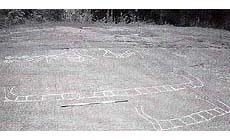|
|
 |
 |
Country: |
Sweden |
Locality: |
Örsta, Angarn 62 |
|
 |
Region: |
Uppland |
Area: |
Angarn |
|
 |
 |
|
|
|
|
| |
 |
Environment & Surface |
 |
 |
 |
|
Open-air
Shelter
Cave
Portable
Megalithic
|
Geography: |
N edge of a major ridge. Slope 12° N, the carving facing N. |
Proximity: |
Close to path. Lake Angarn is situated c. 500 m NW of the locality. |
|
 |
Geology: |
|
Surface: |
Wide flat surface, rough rock. Surface grooved by ice down slope |
|
|
|
|
 |
 |
|
|
|
|
| |
 |
Art |
 |
 |
 |
Description: |
Engravings
Paintings
Painted engravings
High or low-relief
Sculpture
Örsta, Angarn 62. The carving is situated on a wide flat rock, facing N. There are 5 distinct figures, but there may exist other figures on the same panel. The surface is rough. There are 2 ship figures, 155 cm and 360 cm long with extended prows turned up-and inwards. The larger ship has animal shaped prow decoration, possibly horses. There are vertical frame-strokes in the hulls. There are 2 horses, carved in a curvilinear style, reminiscent of the Brandskog ship. The wagon is merely a very sophisticated arrangement of four cups in circles joined in pairs of curved lines, but the effect is wagon-like, and there is a linking line to one of the horses.
|
Figures: |
total number 5
2 ship figures
2 horses
1 wagon
|
|
 |
Chronology: |
Palaeolithic
Epipalaeolithic - Mesolithic
Neolithic
Copper Age
Bronze Age
Iron Age
Roman
Middle Age
Modern
Unknown
The Uppland carvings are most north-easterly of the concentrations of south Scandinavian rock art tradition. The rock carvings of Uppland are generally dated to the middle and later part of the Bronze Age, c. 1200-500 BC. Occasionally, more absolute dating of single panels or figures can be made, based on typological or stylistic features of the image, and by comparisons with identifiable objects. Where a carving has the same object shown, or it is in the same style or has the same decoration as other objects dated to the Bronze Age from graves and hoards, then we can begin to apply some dating to the carvings.
|
Notes: |
The province of Uppland is one of the major rock carving areas in the South Scandinavian rock carving tradition, together with Östergötland, Skåne and Bohuslän. The land is low, with shallow valleys and a few dominant hills or ridges, but it is dotted by small "islands" of rock protruding through the soils, and sometimes by long ridges of rock all sculptured by weathered and by the ancient ice sheets. There are about 700 rock carving sites, and the carvings are found on the above described outcrops of smooth rock along the Bronze Age shoreline (1800 BC at 20 m a s, 1000 BC c. 15 m a s). The Örsta locality consists of only 5 figures, but deeply carved and very distinct and large in size. |
|
 |
 |
|
| |
 |
Bibliography |
 |
|
|
|
|
| |
 |
Conservation |
 |
 |
 |
Status: |
Public
Private
Park
Classified site
|
Risk: |
The rock carvings are fragile and the major risk are chemical weathering, which makes the hard quartzite losen up and fall out, leaving white dots on the darker rock surface. Also natural weathering (mechanical weathering) during winter/spring, when water freeze in cracks and openings in the rock, creates major damage to rock faces with carvings. The biological weathering is also a danger to the rock carvings, and even to intense cleaning of the rock surface during documentation can make the rock fragile and expose the carvings to wind, water and air-born pollution. |
|
 |
Conservation: |
Good
Quite good
Mediocre
Bad
|
Intervention: |
Problems concerning conservation and preservation, registration and documentation of rock carvings in Scandinavia are discussed by several departments, i.e. Riksantikvaren in Norway, Riksantikvarieämbetet in Sweden, several universities and research departments. Different methods are tested, for example covering of carved surfaces, measuring of temperature and different contents in water and air and also the composition in the granite. Hollows and cracks in the rock surface can be repaired and carefully filled in. |
|
 |
 |
|
|
 |
By |
 |
|
| |
| Record n. 743 / 807 |
No commercial use is allowed. Specific © is mentioned in the captions or owned by each Author or Institution |
|
| |
 |
EuroPreArt, European Prehistoric Art, is a web-based archaeological project funded by the European Union which aims to establish a lasting data-base of European prehistoric art documentation, to launch the base of an European institutional network and to contribute to the awareness of the diversity and richness of European Prehistoric Art.
It is proposed by: Instituto Politécnico de Tomar (IPT, Portugal),
CUEBC - European University Centre for Cultural Heritage (Italy - Europe),
Consejo Superior de Investigaciones Científicas (España),
Asociación Cultural Colectivo Barbaón (España),
Université de Liège (Belgique),
Gotland University College (Sverige),
University College Dublin (Eire),
Cooperativa Archeologica Le Orme dell'Uomo (Italia),
Study Centre and Museum of Prehistoric Art of
Pinerolo (Italia),
The European Centre for Prehistoric Research in the Alto Ribatejo (Portugal),
ArqueoJovem - a youth NGO (Portugal).
|
|
|
|
 |
|
 NEW: Alpine rock paintings
NEW: Alpine rock paintings



